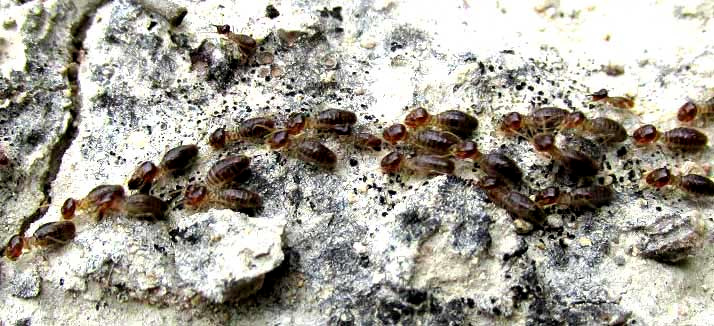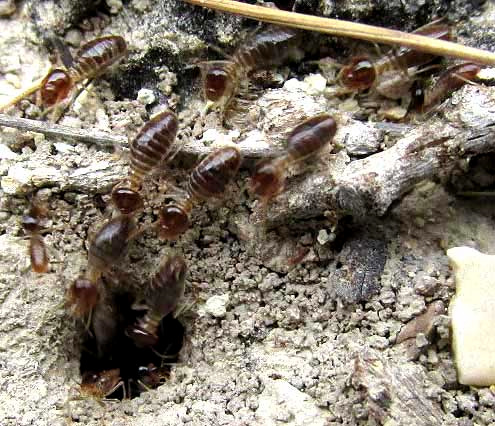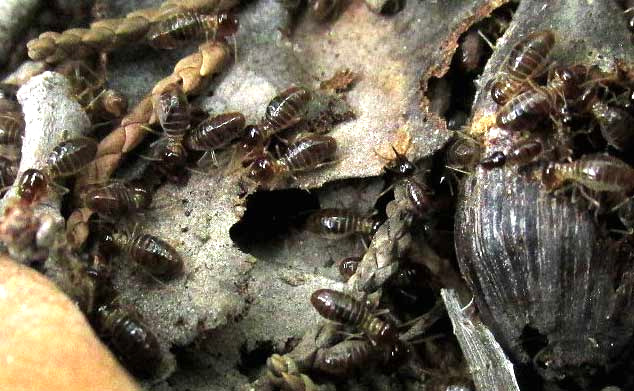Excerpts from Jim Conrad's
Naturalist Newsletter

from the August 24, 2014 Newsletter issued from the Frio Canyon Nature Education Center in the valley of the Dry Frio River in northern Uvalde County, southwestern Texas, on the southern border of the Edwards Plateau; elevation ~1750m (~5750 ft); N29.62°, W99.86°; USA
TERMITES WITH HIGHLY SPECIALIZED SOLDIERS
At the edge of a small roadcut through solid, naked limestone sparsely littered with dried-out juniper stems, liveoak leaves and dried-out grassblades, a dark line of what I assumed to be ants streamed from a dark cluster of the creatures into a hole in a crack in the rock two feet away. That's a small section of the presumed ants above.
They were too small and fast-moving to see much about them, but from the beginning I wondered if they really were ants. In their line they kept much closer together than ants. Ants that close would tangle in one another's gangling legs. Also these roadcut creatures moved slower, more fluidly than ants. In fact, the streaming bodies reminded me of a narrow stream of dark liquid flowing across the limestone. Of course, once the above picture was on the laptop's screen I could see that with those thick bodies these weren't ants at all. They looked like termites, but I'd never seen such small termites, and I've not seen termites in such a rocky environment practically devoid of wood. Adding to the mystery, in the above picture notice the presence of at least two individuals much smaller than the others.
Though it was mid-morning, heavy overcast blotted out the sun, so I had to use a slow shutter speed on the camera. That explains why in my picture of them plunging into their hole some of their bodies are blurred because they were moving so fast, as you can see below:

When I'd first arrived, all the termites had been streaming from one spot among a cluster of liveoak leaves toward their hole, apparently already abandoning whatever had attracted them to that place. When I poked at their cluster hoping to see what they were doing, it only hastened their flight, and I never did figure out what they were doing in that spot.
 Once nearly all the workers had gone underground, two individuals still out on the rock were photographed. They turned out to be the tiny ones, shown at the right, and the amazing thing is that these smaller ones bore long, pointy snouts..
Once nearly all the workers had gone underground, two individuals still out on the rock were photographed. They turned out to be the tiny ones, shown at the right, and the amazing thing is that these smaller ones bore long, pointy snouts..
A photo of the last workers on the surface as they enter their hole gives us a better look at the smaller ones with their long, sharp snouts, as shown below:

Using BugGuide.Net's taxonomy "browse" function, identifying these termites was easier than I could have hoped (Volunteer identifier Bea in Ontario being on vacation). Our pictures show TENUIROSTRITERMES CINEREUS, a species apparently found only in arid northeastern Mexico (Veracruz, Tamaulipas) and south-central Texas. Very little information is available about their life history and behavior, so I'm particularly happy to make this posting.
Though little has been written about Tenuirostritermes cinereus, another species of the same genus, Tenuirostritermes tenuirostris, occurs in Arizona, and it's been studied. One can assume many similarities of behavior between the two species. A 1974 paper on Tenuirostritermes tenuirostris by WL Nutting et al, mainly about the behavior of the smaller, pointy-headed ones -- which turn out to be the soldiers -- is freely downloadable in PDF format at the ResearchGate.Net website.
From that document I learn that our roadcut termite belongs to a subfamily of Termites, the Nasutitermitinae, regarded as containing the most highly specialized of termites. In more primitive termite species, the soldiers are equipped with fairly standard pincer-mandibles. The advanced specialization of the Nasutitermitinae's soldiers consists of the more primitive pincers having evolved through time into "non-functional stubs" -- the sharp points at the head's front end -- while at the same time the pointed snout became a sort of gun that could shoot for a fair distance droplets of liquid capable of incapacitating enemies, especially ants. This shooting apparatus is referred to as the "fontanellar gun." The paper says that "This fontanellar gun represents the apex of sophistication among the varied chemical defense mechanisms of the termites."
The above paper on the New Mexico species describes amazing coordination between the workers and soldiers. For example, before columns of workers begin their foraging, they gather in roundish clusters around their nest holes, with soldiers posted all around the cluster's periphery with their snouts pointed outwards. When workers return to their holes, soldiers are the last to enter the hole. This probably explains why the last individuals I photographed were soldiers. Also, it gives context to the second picture where soldiers were positioned at the hole's edge with their "guns" pointed outward as workers poured into the hole.
This was a wonderful find, and I'm tickled to document the species here. For future researchers needing exact location information, the nest lay about 500 meters north of the Uvalde/Real County line, in Real County, Texas, along the gravel road running up the valley of the Dry Frio River.
from the September 7, 2014 Newsletter issued from the Frio Canyon Nature Education Center in the valley of the Dry Frio River in northern Uvalde County, southwestern Texas, on the southern border of the Edwards Plateau; elevation ~1750m (~5750 ft); N29.62°, W99.86°; USA
TERMITES AT WORK
Last month when I observed those termites I only got to see them streaming across a small patch of earth and entering their hole. I hadn't been able to figure out anything about how the species makes its living, and very little information about it is available on the Internet.
This week in the same general area another colony turned up, and this time I got to see what appeared to be numerous workers (guarded by a few sharp-snouted solders) stationed atop certain thin, dry flakes of tree bark and dried-crisp flower-bud scales, seemingly chewing or cutting chunks from these materials. You can see this below:

A line of these termites extending from this general area to their nest hole included several workers carrying what appeared to be material they'd cut from the debris shown in the picture.
That's not Earth-shattering information but, with this uncommonly observed, little known species, it's something, and I'm glad to post this information here, for future researchers.